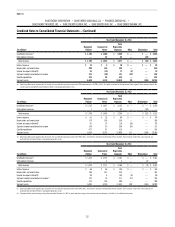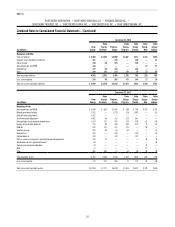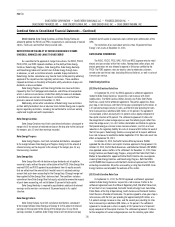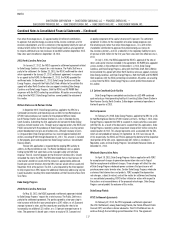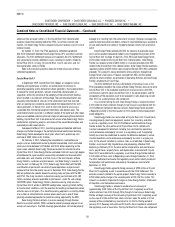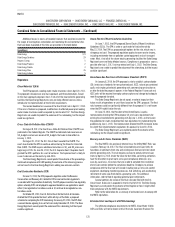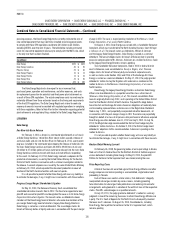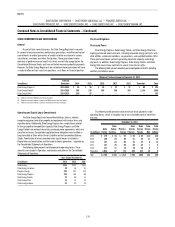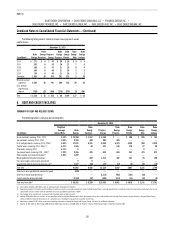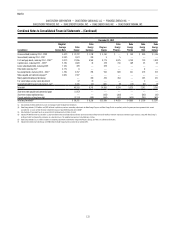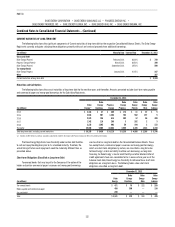Duke Energy 2013 Annual Report Download - page 140
Download and view the complete annual report
Please find page 140 of the 2013 Duke Energy annual report below. You can navigate through the pages in the report by either clicking on the pages listed below, or by using the keyword search tool below to find specific information within the annual report.
122
PART II
DUKE ENERGY CORPORATION • DUKE ENERGY CAROLINAS, LLC • PROGRESS ENERGY, INC. •
DUKE ENERGY PROGRESS, INC. • DUKE ENERGY FLORIDA, INC. • DUKE ENERGY OHIO, INC. • DUKE ENERGY INDIANA, INC.
Combined Notes to Consolidated Financial Statements – (Continued)
Over the course of construction of the project, Duke Energy Indiana
recorded pretax charges of approximately $897 million related to the
Edwardsport project, including the settlement agreement discussed above.
Of this amount, pretax impairment and other charges of $631 million were
recorded during the year ended December 31, 2012. These charges were
recorded in Impairment charges and Operations, maintenance and other
on Duke Energy Indiana’s Consolidated Statements of Operations and
Comprehensive Income.
The Joint Intervenors appealed the IURC order approving the 2012
Edwardsport settlement and other related regulatory orders to the Indiana Court
of Appeals. A nal decision is anticipated mid-2014.
The project was placed in commercial operation in June 2013. Costs for
the Edwardsport IGCC plant are recovered from retail electric customers via a
tracking mechanism, the IGCC Rider.
OTHER REGULATORY MATTERS
Merger Appeals
On January 9, 2013, the City of Orangeburg and NC WARN appealed the
NCUC’s approval of the merger between Duke Energy and Progress Energy.
On April 29, 2013, the NCUC granted Duke Energy’s motion to dismiss certain
exceptions contained in NC WARN’s appeal. On November 6, 2013, the North
Carolina Court of Appeals heard oral arguments on the appeals. A decision from
the North Carolina Court of Appeals is pending.
Progress Energy Merger FERC Mitigation
In June 2012, the FERC approved the merger with Progress Energy,
including Duke Energy and Progress Energy’s revised market power mitigation
plan, the Joint Dispatch Agreement (JDA) and the joint Open Access
Transmission Tariff. The revised market power mitigation plan provides for the
acceleration of one transmission project and the completion of seven other
transmission projects (Long-term FERC Mitigation) and interim rm power sale
agreements during the completion of the transmission projects (Interim FERC
Mitigation). The Long-term FERC Mitigation is expected to increase power
imported into the Duke Energy Carolinas and Duke Energy Progress service
areas and enhance competitive power supply options in the service areas.
These projects are expected to be completed in 2014. On August 8, 2012, FERC
granted certain intervenors’ request for rehearing for further consideration.
Following the closing of the merger, outside counsel reviewed Duke
Energy’s mitigation plan and discovered a technical error in the calculations.
On December 6, 2013, Duke Energy submitted a ling with the FERC disclosing
the error and arguing that no additional mitigation is necessary. On February 4,
2014, The City of New Bern, North Carolina led comments to Duke Energy’s
ling. Duke Energy’s response to New Bern was led on February 19, 2014.
Duke Energy cannot predict the outcome of this matter.
Planned and Potential Coal Plant Retirements
The Subsidiary Registrants periodically le Integrated Resource Plans
(IRP) with their state regulatory commissions. The IRPs provide a view of
forecasted energy needs over a 10-20 year period, and options being considered
to meet those needs. The IRPs led by the Subsidiary Registrants in 2013, 2012
and 2011 included planning assumptions to potentially retire certain coal-red
generating facilities in South Carolina, Florida, Indiana and Ohio earlier than
their current estimated useful lives. The facilities do not have the requisite
emission control equipment, primarily to meet EPA regulations that are not
yet effective.
The table below contains the net carrying value of generating facilities
planned for early retirement or being evaluated for potential retirement included
in Property, plant and equipment, net on the Consolidated Balance Sheets.
December 31, 2013
Duke
Energy
Duke
Energy
Carolinas(b)
Progress
Energy(c)
Duke
Energy
Florida(c)
Duke
Energy
Ohio(d)
Duke
Energy
Indiana(e)
Capacity (in MW) 2,447 200 873 873 706 668
Remaining net
book value
(in millions)(a) $ 260 $ 14 $ 113 $ 113 $ 10 $ 123
(a) Included in Property, plant and equipment, net as of December 31, 2013, on the Consolidated Balance
Sheets.
(b) Includes Lee Units 1 and 2. Excludes 170 MW Lee Unit 3 that is expected to be converted to gas in 2014.
Duke Energy Carolinas expects to retire or convert these units by December 2020 in conjunction with a
settlement agreement associated with the Cliffside Unit 6 air permit.
(c) Includes Crystal River Units 1 and 2.
(d) Includes Beckjord Units 4 through 6 and Miami Fort Unit 6. 150 MW Beckjord Station Unit 4 was retired
on February 17, 2014. Beckjord units have no remaining book value.
(e) Includes Wabash River Units 2 through 6. Wabash River Unit 6 is being evaluated for potential conversion
to gas. Duke Energy Indiana committed to retire or convert these units by June 2018 in conjunction with a
settlement agreement associated with the Edwardsport air permit.
Duke Energy continues to evaluate the potential need to retire these
coal-red generating facilities earlier than the current estimated useful lives,
and plans to seek regulatory recovery for amounts that would not be otherwise
recovered when any of these assets are retired. However, such recovery,
including recovery of carrying costs on remaining book values, could be subject
to future regulatory approvals and therefore cannot be assured.
5. COMMITMENTS AND CONTINGENCIES
GENERAL INSURANCE
The Duke Energy Registrants have insurance and reinsurance coverage
either directly or through indemnication from Duke Energy’s captive insurance
company, Bison, and its afliates, consistent with companies engaged in
similar commercial operations with similar type properties. The Duke Energy
Registrants’ coverage includes (i) commercial general liability coverage
for liabilities arising to third parties for bodily injury and property damage;
(ii) workers’ compensation; (iii) automobile liability coverage; and (iv) property
coverage for all real and personal property damage. Real and personal property
damage coverage excludes electric transmission and distribution lines, but
includes damages arising from boiler and machinery breakdowns, earthquakes,
ood damage and extra expense, but not outage or replacement power
coverage. All coverage is subject to certain deductibles or retentions, sublimits,
exclusions, terms and conditions common for companies with similar types of
operations.
The Duke Energy Registrants self-insure their electric transmission and
distribution lines against loss due to storm damage and other natural disasters.
As discussed further in Note 4, Duke Energy Florida maintains a storm damage
reserve and has a regulatory mechanism to recover the cost of named storms
on an expedited basis.


